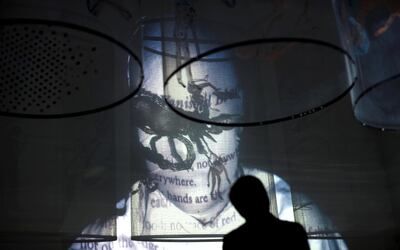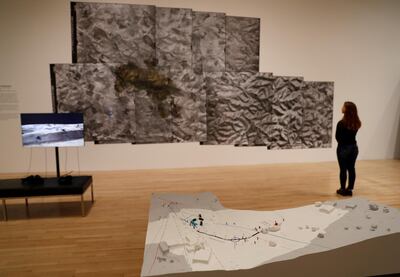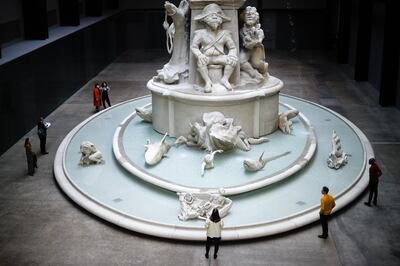What were the top 10 works of the past 10 years? The National canvassed curators, critics and artists in the UAE and across the globe to find out what works floored them in the past decade – a deliberately subjective criterion, looking for works that elicited emotion and passion as much as appreciation and admiration. The exercise was revealing. The French did very well, particularly the group of artists once associated with curator Nicolas Bourriaud and the socially inclined “relational aesthetics” movement of the mid-1990s, proving that experience and longevity build a practice after all: Pierre Huyghe, Philippe Parreno, and the slightly younger Tino Sehgal all received several nominations.
The case was also made for the big art exhibitions, with a number coming from Carolyn Christov- Bakargiev’s Documenta 13 in 2012 and from the Sharjah Biennials of 2015 and 2017 (including a number of nominations not listed here). Formally, research-based works and video installations delivered nuanced readings of subjects, suggesting art is continuing into essayistic and documentary territory – and, with artists such as Forensic Architecture and Lawrence Abu Hamdan, into the crossover between art and activism. At the same time, single sculptures capable of landing a confident, visually led punch still held their own, such as Kara Walker’s fountain for Tate Modern.
And finally, thematics. Even in its most critical guise, art remains one of the most important ways of memorialising victims and questioning the reasons for conflict. But the 2010s will be remembered as the decade when one set of concerns in particular entered artistic consciousness: the ecological crisis and animal studies. These will likely – sadly – become even more relevant in the years to come. However, it’s not all depressing news. These 10 pieces represent almost a 10th of the nominations received, showing that an extraordinary amount of amazing work was produced this decade.
Apichatpong Weerasethakul, Primitive, 2009
This seven-video installation melds Thai folklore and science fiction to convey the lives of young Thai men at the moment where economic stagnation meets the hopefulness of youth. Made by Thai filmmaker Apichatpong Weerasethakul, who works both in art and feature film, the videos are stylish and poised: an opening vote for the strength of spectacle and authorial voice.
Beatriz Gonzalez, Auras anónimas [Los Columbarios], 2009
In the early 2000s, the city of Bogota demolished part of a vast columbarium in the centre of town. Colombian artist Beatriz Gonzalez covered the remaining niches with silhouettes memorialising the victims of the country’s violence: the outlines of people carrying bodies slung on to poles or bundled in blankets. It operated both at a nationwide level of scale – she covered 8,957 niches in total – as well as the intimate level of each burial niche.
Amar Kanwar, Sovereign Forest, 2011
This complex and evolving installation tells the story of one province in India, Odisha, which has been ravaged not only by resource extraction but by the ensuing fighting over land and power. But Odisha (formerly Orissa) is unique in that local communities have successfully resisted development, safeguarding the land and their claim to it. The artwork comprises Kanwar’s films of Odisha as well as material evidence he invites visitors to submit, making Sovereign Forest not only a document of India’s history, but a questioning of how one creates an archive and who has the authority to challenge corporations and the state.
Pierre Huyghe, Untilled, 2011–12
Nestled within the grand park of a German schloss during Documenta 13, Pierre Huyghe created a vision of the post-apocalyptic future, with a mound of composting plants with psychotropic and medicinal properties, a greyhound with a fluorescent-pink leg named “Human”, and a classical sculpture of a woman reclining that was heated from the inside and swapped by bees. The effect was menacing, eerie: it was not a world that had gone to waste, but a world that had been altered, and lost.
Ahlam Shibli, Death, 2011–12
Death, a series of 68 photographs by Palestinian artist Ahlam Shibli, looks at the iconography of the martyr poster, centring on those from the Second Intifada of 20002005 in Nablus. Shibli situates her enquiry not simply on the posters themselves, typically of a young man, rifle in hand, but on how they appear in the homes and Palestinians's daily lives, where they visually dominate a scene but not the goings-on within it: under one enormous poster, an older woman smiles as she dresses a baby in the lap of a young mother. In a living room, a poster hovers on the wall while a family trains its attention on the TV. The work underscores the importance of the visual narrative of Palestinian resistance, both as a means of galvanising response and as a ubiquitous element among its residents.
Kader Attia, Repair from Occident to Extra-Occidental Cultures, 2012
French-Algerian artist Kader Attia received several nominations for his works, but I am asserting authorial privilege for The Repair from Occident to Extra-Occidental Cultures, which was also shown at Documenta 13. A work of extraordinary lucidity, Attia places African masks and photographs side-by-side with copies of European Modernist statues, inverting the value systems that privilege western learning, copied and disseminated through books and images, over authentic items of material culture from the Global South. The artworks in the room were arranged across shelving, evoking libraries and museum archives, as well as the idea of the grid, that foundational concept to western Minimalism and post-war art.
Nalini Malani, In Search of Vanished Blood, 2012
The ambition of this work is astounding. It traces the confluence of Hindu and ancient Greek mythology, mixes this with recent Indian history, German literature, and a little bit of Samuel Beckett, and then focuses on one aspect in particular: the role of women, and their millennia-long fight for independence and equality. Indian artist Nalini Malani’s work is immersive, with ancient forms, animals and goddesses appearing as in shadow projections, in forms of theatre and proto-cinema that transcend fixed geographical notions of how we receive image and sound.
Forensic Architecture – The Gaza Platform, 2014
Working with three non-governmental organisations, the team that make up Forensic Architecture mapped out a conflict that took place in Gaza in 2014 that was sparked by the killing of three Israeli teenagers by Hamas. The deaths resulted in the largest public repository of information about the event, which included records of the deaths of more than 2,200 people, six hundred of whom were children. The Gaza Platform is exemplary of the London group’s blend of forensic analysis, which focuses on changes to the built environment, conventional investigative tools and fluency in both art and human rights arenas. The Gaza Platform was shown at Macba, the contemporary art museum of Barcelona, in 2017, as well as furnishing material for other investigations.
Lawrence Abu Hamdan, Saydnaya (the missing 19db), 2017
For this work, from Sharjah Biennial 2017, Lebanese-British artist Lawrence Abu Hamdan shows the fruits of his research into Saydnaya Prison, where anti-Assad protesters and fighters were interred and kept completely in the dark. Abu Hamdan, who calls himself a “private ear”, worked with them to reconstruct their memories from aural clues, and then restaged the sensations of sound for visitors, using the prisoners’ sensory deprivation as a springboard for an understanding of the torture they endured.
Kara Walker’s Fons Americanus, 2019
Earlier this year American artist Kara Walker unveiled this enormous fountain in the cavernous spaces of Tate Modern, updating the European-style public fountain to reflect the barbaries of racism and the British Empire. The statues festooning the work tell stories from the histories of African slave ships: a figure swimming in the water, or a boy crying in hands. The figure atop is an Afro-Brazilian priestess, rising above it all in a dance of joy and blessing.










